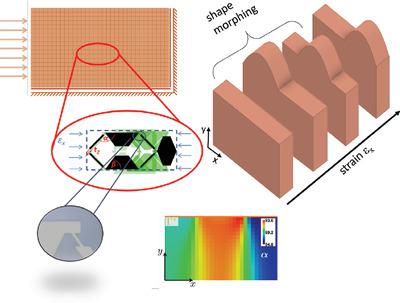当前位置:
X-MOL 学术
›
Adv. Mater.
›
论文详情
Our official English website, www.x-mol.net, welcomes your
feedback! (Note: you will need to create a separate account there.)
Designing Shape Morphing Behavior through Local Programming of Mechanical Metamaterials
Advanced Materials ( IF 27.4 ) Pub Date : 2021-08-02 , DOI: 10.1002/adma.202008617 Franziska Wenz 1, 2 , Ingo Schmidt 1 , Alexander Leichner 3 , Tobias Lichti 3 , Sascha Baumann 4 , Heiko Andrae 3 , Christoph Eberl 1, 2
Advanced Materials ( IF 27.4 ) Pub Date : 2021-08-02 , DOI: 10.1002/adma.202008617 Franziska Wenz 1, 2 , Ingo Schmidt 1 , Alexander Leichner 3 , Tobias Lichti 3 , Sascha Baumann 4 , Heiko Andrae 3 , Christoph Eberl 1, 2
Affiliation

|
Shape morphing implicates that a specific condition leads to a morphing reaction. The material thus transforms from one shape to another in a predefined manner. In this paper, not only the target shape but rather the evolution of the material's shape as a function of the applied strain is programmed. To rationalize the design process, concepts from informatics (processing functions, for example, Poisson's ratio (PR) as function of strain: ν = f(ε) and if-then-else conditions) will be introduced. Three types of shape morphing behavior will be presented: (1) achieving a target shape by linearly increasing the amplitude of the shape, (2) filling up a target shape in linear steps, and (3) shifting a bulge through the material to a target position. In the first case, the shape is controlled by a geometric gradient within the material. The filling kind of behavior was implemented by logical operations. Moreover, programming moving hillocks (3) requires to implement a sinusoidal function εy = sin (εx) and an if-then-else statement into the unit cells combined with a global stiffness gradient. The three cases will be used to show how the combination of mechanical mechanisms as well as the related parameter distribution enable a programmable shape morphing behavior in an inverse design process.
中文翻译:

通过机械超材料的局部编程设计形状变形行为
形状变形意味着特定条件会导致变形反应。因此,材料以预定的方式从一种形状转变为另一种形状。在本文中,不仅对目标形状进行了编程,而且还对作为所施加应变的函数的材料形状的演变进行了编程。为了使设计过程合理化,信息学的概念(处理函数,例如,作为应变函数的泊松比 (PR):ν = f(ε) 和 if-then-else 条件)将被引入。将介绍三种类型的形状变形行为:(1) 通过线性增加形状的幅度来实现目标形状,(2) 以线性步骤填充目标形状,以及 (3) 将凸起通过材料移动到目标位置。在第一种情况下,形状由材料内的几何梯度控制。填充类行为是通过逻辑操作实现的。此外,对移动小丘 (3) 进行编程需要实现一个正弦函数 ε y = sin (ε x) 和一个 if-then-else 语句结合全局刚度梯度进入单元格。这三个案例将用于展示机械机制的组合以及相关参数分布如何在逆向设计过程中实现可编程的形状变形行为。
更新日期:2021-09-14
中文翻译:

通过机械超材料的局部编程设计形状变形行为
形状变形意味着特定条件会导致变形反应。因此,材料以预定的方式从一种形状转变为另一种形状。在本文中,不仅对目标形状进行了编程,而且还对作为所施加应变的函数的材料形状的演变进行了编程。为了使设计过程合理化,信息学的概念(处理函数,例如,作为应变函数的泊松比 (PR):ν = f(ε) 和 if-then-else 条件)将被引入。将介绍三种类型的形状变形行为:(1) 通过线性增加形状的幅度来实现目标形状,(2) 以线性步骤填充目标形状,以及 (3) 将凸起通过材料移动到目标位置。在第一种情况下,形状由材料内的几何梯度控制。填充类行为是通过逻辑操作实现的。此外,对移动小丘 (3) 进行编程需要实现一个正弦函数 ε y = sin (ε x) 和一个 if-then-else 语句结合全局刚度梯度进入单元格。这三个案例将用于展示机械机制的组合以及相关参数分布如何在逆向设计过程中实现可编程的形状变形行为。











































 京公网安备 11010802027423号
京公网安备 11010802027423号